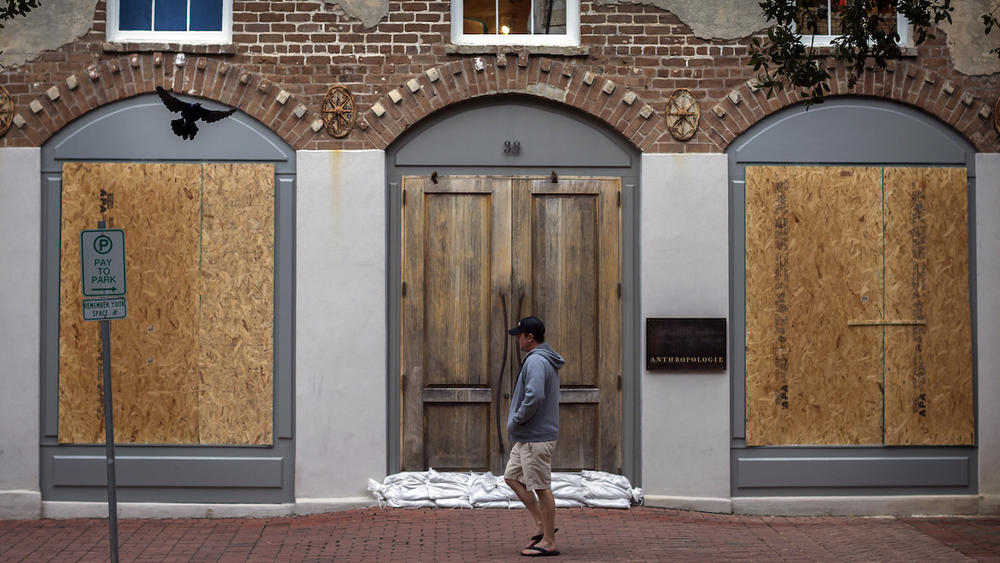Section Branding
Header Content
Irma Prompts 1st Ever Tropical Storm Warning For Atlanta
Primary Content
Widespread threats from Hurricane Irma prompted Georgia's governor to declare an emergency Sunday for the entire state, where coastal Savannah was evacuated for the second time in less than a year and Atlanta faced its first-ever tropical storm warning.
Much of eastern Alabama and coastal South Carolina were also under tropical storm warnings as Irma roared into Florida as a deadly Category 4 hurricane. The National Hurricane Center predicted the storm would cross Monday into southwest Georgia, where a hurricane warning was in effect for a large rural area including the cities of Albany and Valdosta.
"Folks, we must take this storm seriously," Alabama Gov. Kay Ivey told a Sunday news conference.
With Irma packing tropical storm winds more than 200 miles from its center Sunday, threats of punishing wind and heavy rain extended far from the expected path of its eyewall.
The National Weather Service in Peachtree City, Georgia, confirmed that Atlanta — more than 250 miles inland from either the Atlantic or Gulf coasts — was under a tropical storm warning for the first time. Thousands of evacuees from Florida swarmed into Atlanta for shelter as they fled Irma earlier in the week.
Forecasters said metro Atlanta could expect peak winds of 30-40 mph and gusts up to 55 mph on Monday, with a likelihood of falling limbs and trees blocking roadways and snapping power lines.
Meanwhile, Georgia's oldest city sat nearly empty Sunday. Nearly 540,000 people in Savannah and the rest of coastal Georgia were under evacuation orders for the second time since last October, when Hurricane Matthew raked the coast en route to South Carolina.
Forecasters said Irma could push 4-6 feet of storm surge into coastal areas as far north as Charleston, South Carolina. In Georgia, similar surge threatened to submerge the only road linking Tybee Island, Georgia, to Savannah on the mainland for hours, said Dennis Jones, emergency management director for Chatham County.
Tropical storm winds were expected in Savannah as well, prompting authorities Sunday afternoon to close the towering Talmadge Memorial Bridge that spans the Savannah River between Georgia and South Carolina.
Jones told reporters Sunday he believes more people evacuated Savannah and nearby communities for Irma than left ahead of Matthew last year.
"If you ride around Chatham County, it's a ghost town," Jones said.
Brian Palmer agreed. He barely had to watch for traffic Sunday in Savannah's normally bustling downtown historic district as he rode a bike home after leaving his car in a parking garage for the duration of the storm. Palmer and his wife planned to stay in their 144-year-old home, which has weathered many storms including the last major hurricane to hit the Georgia coast in 1898.
"It's seen its share of hurricanes," Palmer said. "I can tell from being up in the attic that the roof beams are all original."
Further inland, a hurricane warning was in place for Valdosta and surrounding Lowndes County, where Interstate 75 crosses the Georgia-Florida line. Forecasters predicted winds up to 60 mph on Monday morning with gusts possibly reaching hurricane force of 75 mph.
Lowndes County officials called for voluntary evacuations of their 112,000 residents, according to a news release Sunday. Mobile home residents and Florida evacuees camping in RVs were urged to head to one of seven storm shelters in the area.
More than 20 Alabama counties were under a tropical storm warning Sunday, with the weather service also warning of possible flash flooding.
Meanwhile, shelters were being opened in Tennessee, where forecasts called for Irma to arrive east of Memphis as a tropical depression by late Tuesday or early Wednesday. Officials warned of potential scattered power outages and minor localized flooding.
___
Bynum reported from Savannah. Associated Press reporters Kim Chandler in Montgomery, Alabama, and John Raby in Charleston, West Virginia, contributed to this story.
Bottom Content

